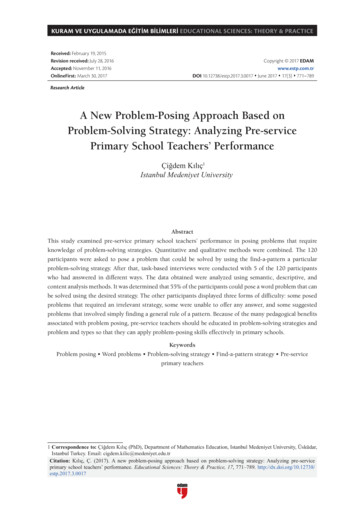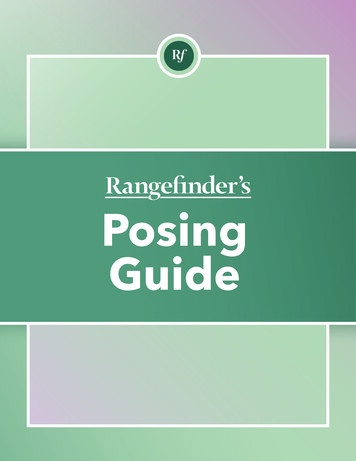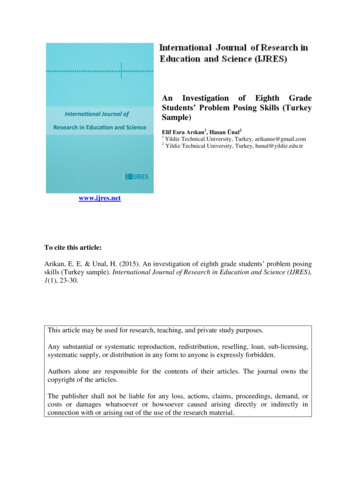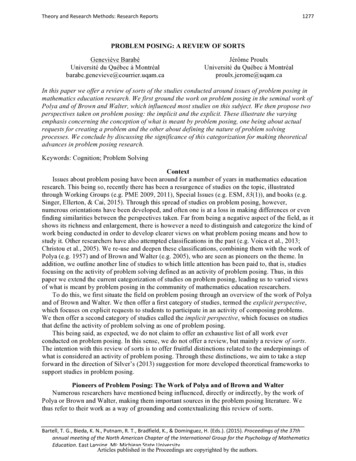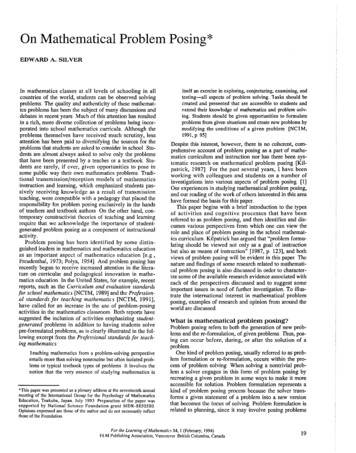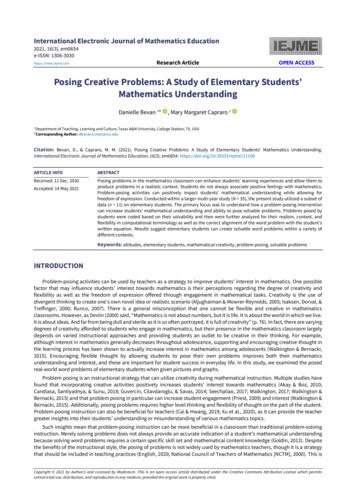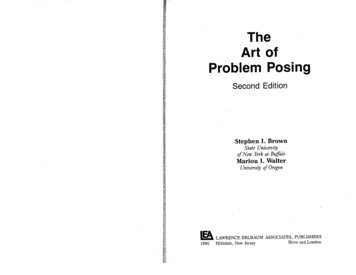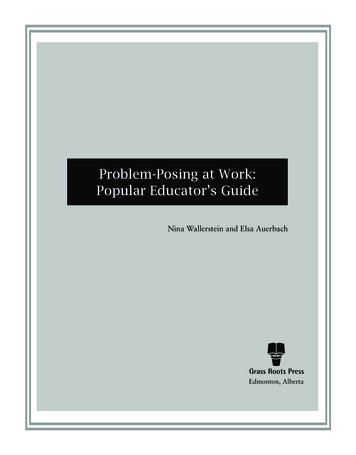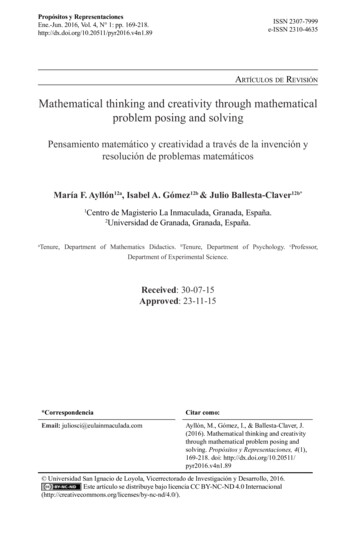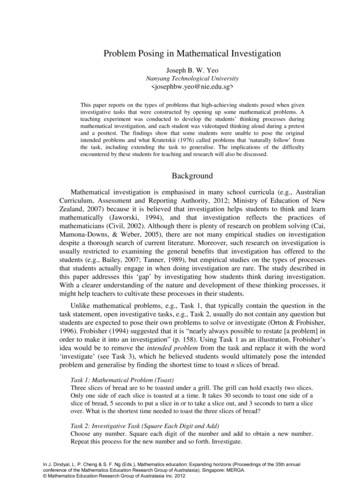
Transcription
Problem Posing in Mathematical InvestigationJoseph B. W. YeoNanyang Technological University josephbw.yeo@nie.edu.sg This paper reports on the types of problems that high-achieving students posed when giveninvestigative tasks that were constructed by opening up some mathematical problems. Ateaching experiment was conducted to develop the students’ thinking processes duringmathematical investigation, and each student was videotaped thinking aloud during a pretestand a posttest. The findings show that some students were unable to pose the originalintended problems and what Krutetskii (1976) called problems that ‘naturally follow’ fromthe task, including extending the task to generalise. The implications of the difficultyencountered by these students for teaching and research will also be discussed.BackgroundMathematical investigation is emphasised in many school curricula (e.g., AustralianCurriculum, Assessment and Reporting Authority, 2012; Ministry of Education of NewZealand, 2007) because it is believed that investigation helps students to think and learnmathematically (Jaworski, 1994), and that investigation reflects the practices ofmathematicians (Civil, 2002). Although there is plenty of research on problem solving (Cai,Mamona-Downs, & Weber, 2005), there are not many empirical studies on investigationdespite a thorough search of current literature. Moreover, such research on investigation isusually restricted to examining the general benefits that investigation has offered to thestudents (e.g., Bailey, 2007; Tanner, 1989), but empirical studies on the types of processesthat students actually engage in when doing investigation are rare. The study described inthis paper addresses this ‘gap’ by investigating how students think during investigation.With a clearer understanding of the nature and development of these thinking processes, itmight help teachers to cultivate these processes in their students.Unlike mathematical problems, e.g., Task 1, that typically contain the question in thetask statement, open investigative tasks, e.g., Task 2, usually do not contain any question butstudents are expected to pose their own problems to solve or investigate (Orton & Frobisher,1996). Frobisher (1994) suggested that it is “nearly always possible to restate [a problem] inorder to make it into an investigation” (p. 158). Using Task 1 as an illustration, Frobisher’sidea would be to remove the intended problem from the task and replace it with the word‘investigate’ (see Task 3), which he believed students would ultimately pose the intendedproblem and generalise by finding the shortest time to toast n slices of bread.Task 1: Mathematical Problem (Toast)Three slices of bread are to be toasted under a grill. The grill can hold exactly two slices.Only one side of each slice is toasted at a time. It takes 30 seconds to toast one side of aslice of bread, 5 seconds to put a slice in or to take a slice out, and 3 seconds to turn a sliceover. What is the shortest time needed to toast the three slices of bread?Task 2: Investigative Task (Square Each Digit and Add)Choose any number. Square each digit of the number and add to obtain a new number.Repeat this process for the new number and so forth. Investigate.In J. Dindyal, L. P. Cheng & S. F. Ng (Eds.), Mathematics education: Expanding horizons (Proceedings of the 35th annualconference of the Mathematics Education Research Group of Australasia). Singapore: MERGA. Mathematics Education Research Group of Australasia Inc. 2012
Task 3: Investigative Task (Toast)Three slices of bread are to be toasted under a grill. The grill can hold exactly two slices.Only one side of each slice is toasted at a time. It takes 30 seconds to toast one side of aslice of bread, 5 seconds to put a slice in or to take a slice out, and 3 seconds to turn a sliceover. Investigate.The purpose of opening up a problem to an investigative task is to allow students to posetheir own problems to solve. But the concern is whether the students know how to pose theintended problems. There also seems to be two different types of investigative tasks thattend to elicit somewhat different kinds of processes: Type A (e.g., Task 2) involvessearching for any pattern by trying examples so as to generalise, while Type B (e.g., Task 3)requires students to first pose a problem like finding the time taken to toast the three slicesand then solve it by using other heuristics such as deductive reasoning. It is beyond thescope of the paper to examine all the thinking processes that students engage in whenperforming both types of investigative tasks, so the paper will focus only on the problemposing processes for Type B tasks. Hence, the research question for the paper is: What kinds of problems did the high-achieving students in this study pose whengiven Type B investigative tasks?Literature ReviewThinking ProcessesClement (2000) observed that one of the most important needs in research on students’thinking processes is the need for insightful explanatory models of these processes, and thatsuch research is most fruitfully undertaken using the thinking-aloud method (Duncker,1926) and teaching experiments (Lesh & Kelly, 2000). Mason, Burton and Stacey (1985)described four main processes in mathematical thinking: specialising (or trying examples),conjecturing, justifying and generalising. Some researchers (e.g., Height, 1989; Cifarelli &Cai, 2004) have also designed a model to depict the thinking processes in investigation.Based on these models but with some modifications, an investigation model (see Fig. 1) wasdeveloped for this study to describe the interaction of these processes. An importantdifference between a mathematical investigation model and a problem-solving model is theadditional phase of problem posing after understanding the task in investigation.Understanding the TaskProblem PosingSpecialisingUsing Other ExtensionFigure 1. Investigation model of thinking processes810
Problem PosingSilver (1994) observed that “problem posing can occur before, during, or after thesolution of a problem” (p. 19). For investigation, problem posing occurs even before thestudents start to think of a solution because they need to pose their own problems to solve.Brown and Walter (2005) discussed two categories of problem posing. The first category isto accept the given in the task statement. There are at least two types of problems in thiscategory. The first type is to search for patterns, e.g., “Is there a pattern? If yes, what is thepattern?” The second type is to generalise if possible, e.g., “Is there a formula? If yes, whatis the formula?” To illustrate the first category of problem posing using Task 2, students cantry examples to look for patterns and then generalise without changing the given.The second category is to extend the task by changing the given using the ‘What-If-Not’strategy. Kilpatrick (1987) discussed taking something that is a constant in the taskstatement and let it vary, while Orton and Frobisher (1996) used the “What if” question toextend a problem by changing the given. Using Task 3 as an illustration, students can ask,“What if there are four slices to be toasted? What if the number of slices the grill can hold isnot two but three?” This kind of extension can also lead to the finding of a general formulafor the time taken to toast the bread. The difference between the process of generalising inthe first and second categories of problem posing is that the former does not involvechanging the given while the latter requires changing the given to extend the task.Krutetskii (1976) argued that there were some problems that ‘naturally follow’ from thegiven task, and he found that high-achieving students were able to pose them directly butlow-achieving students were unable to do so. Using Task 3 as an illustration, students mayask, “What is the time taken to toast the three slices?” or even pose the intended problem:“What is the shortest time needed to toast the three slices?” Students are also expected togeneralise by asking, “Is there a formula to toast n slices?” In fact, they can even go to thenext level of generalisation by asking whether there is a formula to toast n slices if the grillcan hold exactly m slices.Since these problems may be ‘natural’ from the perspective of the person who designsthe task but they may not be ‘natural’ for students to pose, there is a need to distinguish thedifference. In this paper, this kind of problems will be called ‘logical problems’ that followfrom the task because these problems are posed based on a logical sequence. For example,before you can find the least time taken to toast the three slices, you need to find the timetaken to toast the three slices using a few methods first. In line with the research question forthis paper, an area of interest is whether students find it ‘natural’ to pose such ‘logicalproblems’ that follow from the given task, including the intended problem.MethodologyA teaching experiment was conducted with a class of 19 high-achieving students, whohad no prior experience in investigation, to develop their processes when they attemptedboth types of investigative tasks. They were chosen from a bigger pool of high-achievingstudents from the same school by giving each one of them an investigative task and askingthem questions such as whether they had seen this kind of tasks before, and whether theyknew how and what to investigate. Only students who answered ‘no’ for all these questionswere selected. As it was beyond the scope of the present research to study a large group ofstudents with different academic attainments, high-achieving students were chosen because811
an initial exploratory study by the author (Yeo, 2008) has suggested that they were morelikely to exhibit a wider range of investigation processes to inform the investigation model(shown in Fig. 1) than average or low-achieving students.However, the same exploratory study has also revealed that most of the high-achievingstudents with no prior experience in investigation did not really know what and how toinvestigate because they did not understand the task requirements. Thus the students in thecurrent study were given a two-hour familiarisation lesson before the pretest to teach themwhat to investigate. After the pretest, the students were given five two-hour developinglessons to develop their processes further, i.e., to teach them how to investigate. The posttestwas conducted within one week after the last lesson. The pretest and the posttest eachcontained two tasks, one of which was a Type B task. The students were given 30 minutes todo each task. For the pretest, the Type B task was Task 3 described earlier in this paper,while the Type B task for the posttest was as followed:Task 4: Investigative Task (Sausages)I need to cut 12 identical sausages so that I can share them equally among 18 people.Investigate.Unlike traditional textbook exercises where parallel items mean changing the numberswhile retaining the same method of solution, parallel items for investigative tasks could notbe designed in this way, or else the posttest would just be an exercise for the students withnothing new to investigate. Thus the posttest tasks must have different patterns but stillretain the same structure and elicit similar processes as the pretest tasks. For example, Task3 (Pretest) and Task 4 (Posttest) are of the same Type B, and both involve minimising (findleast time and least number of cuts) and generalising using two variables (toast n slices in agrill that can hold exactly m slices, and share n sausages equally among m people).In addition, each student was videotaped thinking aloud during the tests to capture his orher thinking processes, so as to identify the types of processes in order to study theirinteraction among one another, and their development. To prepare the students to thinkaloud during the tests, they practised thinking aloud during the familiarisation lesson and thelast developing lesson. The verbal protocols of the students during the tests were thentranscribed and coded to identify the types of processes. Four representative transcripts witha total of 1258 codes were given to two experienced coders to code. The inter-coderagreement was 93%, suggesting that the coding scheme developed by the author was reliableenough. The coded transcripts were then manually analysed to study the nature anddevelopment of thinking processes in mathematical investigation.To answer the research question in this study on the kinds of problems posed by thestudents, there was a need to look beyond the students’ test answer scripts to their thinkingaloud protocols, because sometimes the students posed a problem verbally without writing itdown in their answer scripts, and it was not easy to guess from their working what theirproblem was. Occasionally, the students posed a problem verbally but they then changedtheir minds, so they did not write the problem down in their answer scripts. Therefore, thestudents’ thinking-aloud protocols complemented their answer scripts in providing a fullerpicture of the kinds of problem the students posed, so as to answer the current researchquestion more reliably.812
Results and DiscussionThe logical problems to pose for Task 3 (Pretest), including the intended problem, insequential order of reasoning as explained earlier in this paper, are: Logical Problem 1 (LP1): Find the time taken to toast the three slices of bread.Logical Problem 2 (LP2): Find the shortest time to toast the three slices of bread(Intended Problem).Logical Extension 1 (LE1): Find the shortest time to toast n slices of bread.Logical Extension 2 (LE2): Find the shortest time to toast n slices of bread if thegrill can hold m slices.The logical problems to pose for Task 4 (Posttest) are: LP1: Find the number of cuts to share the 12 sausages among the 18 people.LP2: Find the least number of cuts to share the 12 sausages among the 18 people(Intended Problem).LE1: Find the least number of cuts to share n sausages among m people.Unlike Task 3 which has two extensions because it is more logical to first change thenumber of slices to be toasted than the number of slices the grill can hold, Task 4 has onlyone extension because it cannot be determined which of the two variables is more logical tochange first. In fact, data analysis has shown that most of the students in this study changedboth the number of sausages and the number of people at the same time. Another interestingfinding for Task 4 was that most students (79%) found it even more natural to pose aproblem that was not LP1 or LP2: LP0: Find how to cut the 12 sausages to share among 18 people.This problem is called LP0 since, in sequential order of reasoning, one has to find howto cut the sausages before finding the number of cuts (LP1). Therefore, a similar LP0 wasalso created for Task 3 as shown in Table 1, which contains a summary of the findings forthe present study. Most students posed more than one problem for each task.Table 1Summary of Findings (total number of students in this study 19)Task 3 (Pretest)No.Logical Problem 0 (LP0): Find how to0toast the 3 slicesLogical Problem 1 (LP1): Find time taken 11to toast the 3 slicesLogical Problem 2 (LP2): Find shortest11time to toast 3 slices (Intended Problem)Logical Extension 1 (LE1): Find7(shortest) time taken to toast n slicesLogical Extension 1 (LE2): Find0(shortest) time taken to toast n slices ifgrill can hold m slicesAttempted any kind of extensions12813Task 4 (Posttest)No.LP0: Find how to cut 12 sausages toshare among 18 peopleLP1: Find number of cuts to share 12sausages among 18 peopleLP2: Find least number of cuts to share12 sausages among 18 people (IntendedProblem)15LE1: Find (least) number of cuts to sharen sausages among m people5Attempted any kind of extensions3619
Problem PosingFor Task 3 (Pretest), data analysis shows that 11 of the 19 students (58%) posed LP1,while 6 students posed LP2, almost immediately after understanding the task. Only twostudents did not know what to pose. Of the students who posed LP1, 5 of them also posedLP2 almost immediately after solving LP1. Thus a total of 6 5 11 students (58%) foundit natural to pose LP2, which was also the intended problem. For Task 4 (Posttest), dataanalysis shows that 3 students posed LP0 explicitly, but 12 students just went ahead to findhow to cut the sausages without posing LP0 at all. It seems that Task 4 was phrased in sucha way that it was very natural for the students to proceed to solve LP0 without even posingit. Thus we might say that a total of 3 12 15 students (79%) found LP0 natural enough topose although the majority did not pose it directly. This was unlike Task 3 where no oneposed LP0 as the students found it more natural to pose LP1 and LP2 instead.However, only 3 students (16%) attempted to find the number of cuts (LP1) for Task 4,as compared to Task 3 where it was natural for the majority (58%) to find the total timetaken to toast the three slices (LP1), probably because the time for each process, such asputting in or taking out a slice, was given in the task statement. For Task 4, a total of 6students (32%) posed LP2 naturally: three of them after solving LP1; one of them aftersolving LP0 without posing LP1; and the last two students after reading the task only once,without even posing LP0 or LP1. For example, one of the last two students said:“I need to cut 12 identical sausages so that I can share them equally among 18 people. Investigate.Cut 12, um, maybe, like, the minimum number of cuts.” [S17; Posttest]From the above analysis, the context and phrasing of a task seem to affect whether thestudents found it natural to pose the logical or intended problems, e.g., fewer students wereable to pose LP1 and LP2 for Task 4 as compared to Task 3, despite the fact that Task 4 wasa posttest task after 10 hours of lessons to develop students’ investigation processes.Moreover, it was not necessary for the students to pose the logical problems in order, e.g.,they could pose LP2 directly, without even posing LP0 or LP1.ExtensionSince some students did not find the shortest time (LP2) for Task 3, all students whoused any toasting method to find a general formula for the toasting time, not necessarily theshortest time, will be included in the analysis. The findings show that it was only natural for7 students (37%) to find the time taken to toast n slices (LE1). No student attempted LE2,but this might be due to the time constraint of the test: 6 of the 7 students ran out of timewhen trying LE1 while the last one just managed to find a general formula. Nevertheless, thelast student did recognise that his formula is only true for the case where the grill can holdexactly two slices and the timings are as those given in the task statement:“And this is the formula for this question. But very sadly, it’s only for this one. So, only when you geta question which has [pause] grill it for 30 seconds, take it down will be 5 seconds, and turn it over is3 seconds, and this must be, and must have, can toast two bread at a time. So then you can get thisnumber and use this formula.” [S04; Pretest]Another 2 students attempted other kinds of generalisation: one of them tried to find aformula to toast n slices if it takes a seconds to put a slice in or to take a slice out, b secondsto toast a slice, and c seconds to turn a slice over, for the case where 0 n 2 (the lattercondition was puzzling); while the other one tried to find the time taken to toast a slice of814
bread that has x number of sides (again it was puzzling how a slice of bread could have, e.g.,5 sides). Nevertheless, a total of 7 2 9 students (47%) extended Task 3 by generalising.A possible reason why so few students generalised was that most of them still did not fullyunderstand they could change the given in the task statement, even after a two-hourfamiliarisation lesson. For example, a student asked the invigilator during the pretest:“Teacher, the investigation must be, um be, related to the question? Like if they say 3, I investigatefinish, can I use 21 slices of bread?” [S12; Pretest]However, 3 other students extended the task without generalising, e.g., toasting the threeslices together in a bigger grill, not a grill that can hold exactly m slices. Thus, a total of 9 3 12 students (63%) extended Task 3 in one way or another.For Task 4, only 5 students (26%) tried to generalise the least number of cuts (LE1). Apossible reason why so few students attempted LE1 was because most of them did not evenfind the number of cuts for the original task (LP1 or LP2). Nevertheless, another 7 studentsdid try to generalise for other reasons, e.g., to find a general formula for the amount ofsausage a person will get, or a general method to cut 6n sausages to share equally among6(n 1) people. Therefore, a total of 5 7 12 students (63%) attempted some kind ofgeneralisation for Task 4, as compared to only 47% for Task 3. However, all the students(100%) extended Task 4 in various ways, as compared to only 63% who extended Task 3.The following show some of the extensions attempted by the students for Task 4:“How to share usage of a computer with 9 brothers over a week?” [S02; Posttest]“If a sausage is a triangle if it is a square ” [S06; Posttest]“We can use 12 different sizes of sausages.” [S18; Posttest]From the above analysis, the 10 hours of developing lessons had helped the students tobe more proficient in extending Task 4 (Posttest) as compared to Task 3 (Pretest), althoughtheir attempt to generalise the number of cuts for Task 4 (LE1) was hampered by theirinability to pose the logical problem of finding the number of cuts for the original task (LP1or LP2). Moreover, the quality of the extension for Task 4 was also higher: the students notonly changed the numbers in the original task statement of the posttest, but they alsochanged other variables such as the size and shape of the sausages, and the context tosharing the usage of a computer.ConclusionThe opening up of mathematical problems to become investigative tasks has providedstudents the opportunity to pose their own problems to solve. But unlike what Krutetskii(1976) has discovered, some high-achieving students in this study did not find it natural topose problems that logically follow from the task. The analysis has also revealed that thecontext of the task and the phrasing of its task statement might affect whether students areable to pose the logical or intended problems, suggesting that teachers could not just designan investigative task by opening up a mathematical problem, as proposed by Frobisher(1994), without considering the possibility of ‘losing’ the logical or intended problems thatthey might want their students to solve. Therefore, there is a need for teachers to mull overhow to guide their students to pose the intended or logical problems that follow from suchinvestigative tasks, and yet not close up the tasks by restricting the students’ freedom andcreativity to pose other types of problems to solve. On the other hand, the students had learnt815
from the teaching experiment how to extend the tasks in different ways, although there wasstill room for improvement in their ability to generalise. This paper has contributed to thecurrent research through documenting the types of problems that students posed duringinvestigation, and suggesting that these problem-posing processes could be developed in amathematically enriched environment, although more research needs to be done to studyhow students cultivate these processes over a longer period of time.ReferencesAustralian Curriculum, Assessment and Reporting Authority (2012). The Australian curriculum. Retrieved Feb28, 2012, from ley, J. (2007). Mathematical investigations: A primary teacher educator’s narrative journey of professionalawareness. In J. Watson & K. Beswick (Eds.), Proceedings of the 30th annual conference of theMathematics Education Research Group of Australasia (MERGA): Mathematics: Essential research,essential practice (Vol. 1, pp. 103-112). Adelaide, Australia: MERGA.Brown, S. I., & Walter, M. I. (2005). The art of problem posing (3rd ed.). Mahwah, NJ: Erlbaum.Cai, J., Mamona-Downs, J., & Weber, K. (2005). Mathematical problem solving: What we know and where weare going. Mathematical Behavior, 24, 217-220.Cifarelli, V., & Cai, J. (2004, July). A framework for examining the mathematical exploration of problemsolvers. Research paper presented to the Special Interest Group on Problem Solving of the InternationalCongress on Mathematics Education, Copenhagen, Denmark.Civil, M. (2002). Everyday mathematics, mathematicians’ mathematics, and school mathematics: Can we bringthem together? In E. Yackel (Series Ed.) & M. E. Brenner & J. N. Moschkovich (Monograph Eds.),Everyday and academic mathematics in the classroom (pp. 40-62). Reston, VA: National Council ofTeachers of Mathematics.Clement, J. (2000). Analysis of clinical interviews: Foundations and model viability. In A. E. Kelly & R. A.Lesh (Eds.), Handbook of research design in mathematics and science education (pp. 547-589). Mahwah,NJ: Erlbaum.Duncker, K. (1926). A qualitative (experimental and theoretical) study of productive thinking (solving ofcomprehensive problems). Pedagogical Seminary, 33, 642-708.Frobisher, L. (1994). Problems, investigations and an investigative approach. In A. Orton & G. Wain (Eds.),Issues in teaching mathematics (pp. 150-173). London: Cassell.Height, T. P. (1989). Mathematical investigations in the classroom. Australia: Longman Cheshire Pty.Jaworski, B. (1994). Investigating mathematics teaching: A constructivist enquiry. London: Falmer Press.Kilpatrick, J. (1987). Problem formulating: Where do good problems come from? In A. H. Schoenfeld (Ed.),Cognitive science and mathematics education (pp. 123-147). Hillsdale, NJ: Erlbaum.Krutetskii, V. A. (1976). The psychology of mathematical abilities in school children. In J. Kilpatrick & I.Wirszup (Series Eds.), Soviet studies in the psychology of learning and teaching mathematics. Chicago:University of Chicago Press.Lesh, R. A., & Kelly, A. E. (2000). Multitiered teaching experiments. In A. E. Kelly & R. A. Lesh (Eds.),Handbook of research design in mathematics and science education (pp. 197-230). Mahwah, NJ:Erlbaum.Mason, J., Burton, L., & Stacey, K. (1985). Thinking mathematically (Rev. ed.). Wokingham, England:Addison-Wesley.Ministry of Education of New Zealand. (2007). The New Zealand curriculum. Retrieved Feb 28, 2012, fromhttp://nzcurriculum.tki.org.nzOrton, A., & Frobisher, L. (1996). Insights into teaching mathematics. London: Cassell.Silver, E. A. (1994). On mathematical problem posing. For the Learning of Mathematics, 14(1), 19-28.Tanner, H. (1989). Introducing investigations. Mathematics Teaching, 127, 20-23.Yeo, J. B. W. (2008). Secondary school students investigating mathematics. In M. Goos, R. Brown, & K.Malar (Eds.), Proceedings of the 31st Annual Conference of the Mathematics Education Research Groupof Australasia (MERGA): Navigating currents and charting directions (Vol. 2, pp. 613-619). Brisbane,Australia: MERGA.816
Mathematical investigation is emphasised in many school curricula (e.g., Australian Curriculum, Assessment and Reporting Authority, 2012; Ministry of Education of New Zealand, 2007) because it is believed that investigation s students to think and learn help mathematically (Jaworski, 1994), and that reflects the practices of investigation
